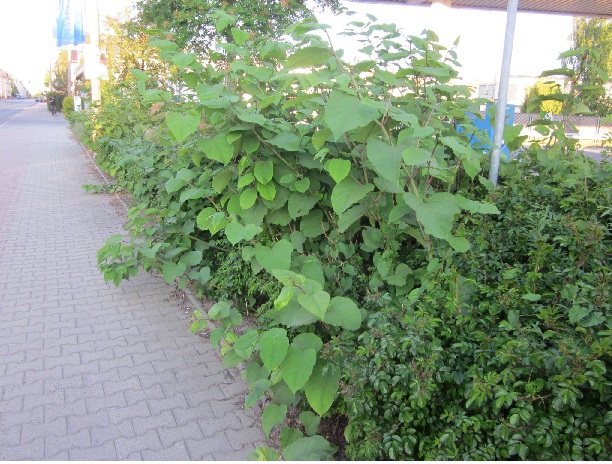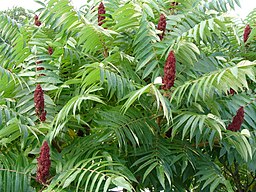 |
Bohemian Knotweed | Status LU: established. 1st record: LU & ITW 2005. |
 |
Béimescht Knuetkraut | Status Eur.: established. 1st record ITW UK 1954. |
 |
Renouée de bohême | RA: ISEIA: B1 – Watch List. Harmonia+: 0,59 |
 |
Bastard-Knöterich | Wikipedia:   | Wikispecies: n/a | CABI | Wikispecies: n/a | CABI |
 |
Boheemse duizendknoop | Back to the list of neophytes |
Contents
Brief description
 Like other Asiatic knotweeds, Fallopia ×bohemica (Chrtek & Chrtková) J. P. Bailey colonises a wide range of environments, with a predilection for moist and nitrogen-rich soils. It prefers sunny places or semi-shaded habitats. This pioneer plant proliferates both in ruderal and semi-natural habitats, including riparian areas and open forests. Stem and rhizomes may easily split into small pieces; fragments are able to regenerate a plant, provided a node is present. The Bohemian knotweed may produce seeds but seedling establishment is usually inefficient due to frost sensitivity. Transport of garden waste and soil contaminated with rhizomes are the major dispersal modes. Where the plant is widely consolidated on river banks it is also spread by floods and can easily colonise downstream.
Like other Asiatic knotweeds, Fallopia ×bohemica (Chrtek & Chrtková) J. P. Bailey colonises a wide range of environments, with a predilection for moist and nitrogen-rich soils. It prefers sunny places or semi-shaded habitats. This pioneer plant proliferates both in ruderal and semi-natural habitats, including riparian areas and open forests. Stem and rhizomes may easily split into small pieces; fragments are able to regenerate a plant, provided a node is present. The Bohemian knotweed may produce seeds but seedling establishment is usually inefficient due to frost sensitivity. Transport of garden waste and soil contaminated with rhizomes are the major dispersal modes. Where the plant is widely consolidated on river banks it is also spread by floods and can easily colonise downstream.
Fallopia xbohemica exhibits hybrid vigour and is reputed to be more invasive than the two parents, F. japonica and F. sachalinensis. It typically forms very dense stands, excluding native vegetation and prohibiting regeneration. It reduces plant and invertebrate species diversity, alters the habitat for wildlife, and changes light and energy conditions of the ecosystem. Once stands become established, they are extremely persistent and difficult to remove. Its development can favour river bank erosion during the winter (Branquart et al. 2010).
Uncertain status of Fallopia × bohemica in Luxembourg
Identification of knotweed species is not always easy, especially the very similar Japanese knotweed (Fallopia japonica) and Bohemian knotweed (Fallopia ×bohemica), a hybrid between Japanese knotweed and Sakhalin knotweed (Fallopia sachalinensis). Until recently, Japanese knotweed was considered much more widespread in Luxembourg than Bohemian knotweed.
During the field trip of the international Neobiota 2016 conference in September 2016, knotweed populations near Michelau that were so far considered as F. japonica, were identified by specialists as F. ×bohemica.
To assess the accuracy of the data collected to date, the Department of Ecology of the Museum carried out a small survey in 2017: 31 specimens of knotweed populations were collected across the country, described and filed in the museum’s herbarium. Genetic analysis of the samples in the museum’s lab showed that in Luxembourg F. ×bohemica is more common than Fallopia japonica. The data of both taxa need to be updated in the Recorder-Lux database (MNHNL, 2000-).
Status and distribution in Luxembourg
Records of Fallopia ×bohemica (Chrtek & Chrtková) J. P. Bailey in Luxembourg. Data source: Recorder-Lux, iNaturalist & GBIF, 2025-06-12.
Currently, 16 records of the hybrid are accessible through the MNHNL-mdata portal (MNHNL, iNaturalist & GBIF 2019). As far as we currently know, the species is distributed along the rivers Mamer, Black Ernz and Gander.
As in the case of Fallopia sachalinensis, the frequency of male-sterile and male-fertile colonies in the environment should be specified. This hybrid, long unknown, is very variable. It could have been formed by spontaneous hybridisation of both parents; but the introduction by horticulturists of hybrid strains is equally, if not more likely (Lambinon & Verloove 2012: 193).
As outlined in the section above, the status of the species has to be revised, as many records could have been misidentified, which is why we describe both Bohemian and Japanese knotweed together in the following section.
Importance and distribution of Bohemian and Japanese knotweed in Luxembourg
Bohemian and Japanese knotweed are common and widespread invasive neophytes in Luxembourg. They build huge colonies along riparian ecosystems, several major rivers of Luxembourg being affected. They regularly grow in small patches along roadsides and in waste grounds, most of these places having been “contaminated” by people getting rid of knotweed clippings from their gardens. Examples can be seen along the main road leaving Luxembourg City in the direction of Echternach. Nurseries and garden designers sometimes contribute to the spread of knotweed in gardens and public green spaces by using contaminated compost.
Risk assessment
ISEIA protocol
B1 (2+2+3+3) = Watch List (Ries et al. 2013: 18). Needs to be reassessed (see above).
Harmonia+ protocol
Overall risk score 0,59 = (Overall Invasion score 0,84 x Overall Impact score 0,70) (Ries et al. 2020).
 Invasion
Invasion0,70

 Impact
Impact0,59

 Risk
RiskWorldwide distribution
Bibliography
- Branquart, E., S. Vanderhoeven, W. Van Landuyt, F. Van Rossum, F. Verloove & A. Vervoort, 2010. Harmonia database: Fallopia ×bohemica (Chrtek & Chrtková) J. P. Bailey. Harmonia version 1.2, Belgian Forum on Invasive Species. URL: http://ias.biodiversity.be [accessed on 2019-10-09]
- Bailey, J.P. & A.P. Conolly, 2000. Prize-winners to pariahs – A history of Japanese Knotweed s.l. (Polygonaceae) in the British Isles. Watsonia. 23: 93–110.[PDF]
- CABI, 2019. Fallopia x bohemica. In: Invasive Species Compendium. Wallingford, UK: CAB International. URL: www.cabi.org/isc [accessed 2020-03-02]
- Glesener, B., M. Pfeiffenschneider & C. Ries, 2009. Die Verbreitung von Impatiens glandulifera, Fallopia japonica, F. sachalinensis, F. ×bohemica und Heracleum mantegazzianum entlang der Hauptfließgewässer Luxemburgs. Bull. Soc. Nat. luxemb. 110: 69-73. [PDF 470 KB]
- Lambinon J. & F. Verloove, 2012. Nouvelle flore de la Belgique, du grand-duché de Luxembourg, du Nord de la France et des régions voisines. Sixième édition. Avec la collaboration de L. Delvosalle, B. Toussaint, D. Geerinck, I. Hoste, F. Van Rossum, B. Cornier, R. Schumacker, A. Vanderpoorten et H. Vannerom. Jardin botanique national de Belgique, Meise. CXXXIX + 1195 pp. ISBN : 9789072619884.
- MNHNL, iNaturalist & GBIF, 2020. Fallopia ×bohemica in MNHNL-mdata, online portal combining species observation from Recorder-Lux, iNaturalist and GBIF. National Museum of Natural History, Luxembourg. URL: https://mdata.mnhn.lu [Accessed 2020-03-02]
- Pfeiffenschneider, M., 2007. Über die Verbreitung von Heracleum mantegazzianum, Impatiens glandulifera, Fallopia japonica und F. sachalinensis entlang der Gewässer Obersauer, Woltz, Clerve, Wiltz und ihrer Nebengewässer (Luxemburg). Bull. Soc. Nat. luxemb. 108: 7-10. [PDF 400 KB]
- Pfeiffenschneider, M., P. Gräser & C. Ries, 2014. Distribution of selected neophytes along the national railway network of Luxembourg. Bull. Soc. Nat. luxemb. 115: 95-100. [PDF 1457 KB]
- Pfeiffenschneider, M., P. Gräser & C. Ries, 2014. Distribution of selected neophytes along the main rivers of Luxembourg. Bull. Soc. Nat. luxemb. 115: 101-108. [PDF 3668 KB]
- Ries, C. & Y. Krippel, 2021. First records of 56 invasive alien vascular plants in Luxembourg. Bulletin de la Société des naturalistes luxembourgeois 123: 115-127. [PDF 241 KB]
- Ries, C., Y. Krippel & M. Pfeiffenschneider, 2020. Risk assessment after the Harmonia+ protocol of invasive alien vascular plant species in Luxembourg. Bull. Soc. Nat. luxemb. 122: 197-205. [PDF 132 KB]
- Ries, C., Y. Krippel, M. Pfeiffenschneider & S. Schneider, 2013. Environmental impact assessment and black, watch and alert list classification after the ISEIA Protocol of non-native vascular plant species in Luxembourg. Bull. Soc. Nat. luxemb. 114: 15-21. [PDF 652 KB]
- Saintenoy-Simon, J. et coll., 2008. Trouvailles floristiques récentes (2006-2007). Adoxa 59: 17-52.
Page content last updated on 2021-03-04. Last proofread by Caroline Grounds on 2019-11-20.



























